Aleut vs Comanche Community Comparison
COMPARE
Aleut
Comanche
Social Comparison
Social Comparison
Aleuts
Comanche
3,609
SOCIAL INDEX
33.6/ 100
SOCIAL RATING
216th/ 347
SOCIAL RANK
1,908
SOCIAL INDEX
16.6/ 100
SOCIAL RATING
283rd/ 347
SOCIAL RANK
Comanche Integration in Aleut Communities
The statistical analysis conducted on geographies consisting of 38,443,050 people shows a perfect positive correlation between the proportion of Comanche within Aleut communities in the United States with a correlation coefficient (R) of 0.954. On average, for every 1% (one percent) increase in Aleuts within a typical geography, there is an increase of 0.008% in Comanche. To illustrate, in a geography comprising of 100,000 individuals, a rise of 1,000 Aleuts corresponds to an increase of 7.7 Comanche.
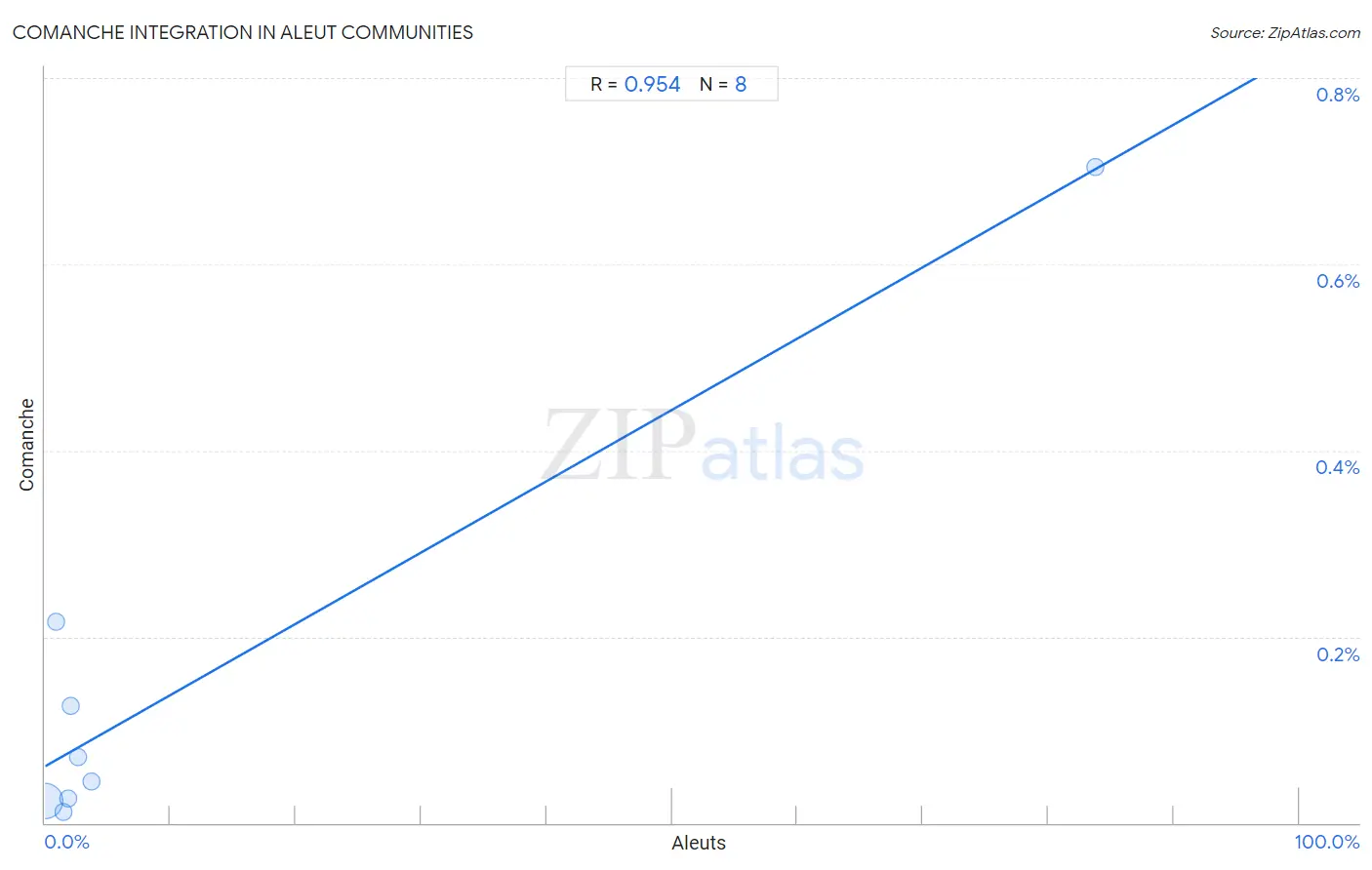
Aleut vs Comanche Income
When considering income, the most significant differences between Aleut and Comanche communities in the United States are seen in householder income ages 45 - 64 years ($100,052 compared to $85,787, a difference of 16.6%), householder income over 65 years ($62,708 compared to $54,922, a difference of 14.2%), and median household income ($83,446 compared to $73,747, a difference of 13.2%). Conversely, both communities are more comparable in terms of wage/income gap (23.7% compared to 25.0%, a difference of 5.4%), householder income under 25 years ($50,377 compared to $47,518, a difference of 6.0%), and median male earnings ($51,168 compared to $48,202, a difference of 6.1%).

| Income Metric | Aleut | Comanche |
| Per Capita Income | Poor $42,210 | Tragic $38,088 |
| Median Family Income | Poor $98,702 | Tragic $88,556 |
| Median Household Income | Fair $83,446 | Tragic $73,747 |
| Median Earnings | Tragic $44,241 | Tragic $41,519 |
| Median Male Earnings | Tragic $51,168 | Tragic $48,202 |
| Median Female Earnings | Poor $38,719 | Tragic $35,661 |
| Householder Age | Under 25 years | Tragic $50,377 | Tragic $47,518 |
| Householder Age | 25 - 44 years | Poor $91,370 | Tragic $82,152 |
| Householder Age | 45 - 64 years | Average $100,052 | Tragic $85,787 |
| Householder Age | Over 65 years | Excellent $62,708 | Tragic $54,922 |
| Wage/Income Gap | Exceptional 23.7% | Excellent 25.0% |
Aleut vs Comanche Poverty
When considering poverty, the most significant differences between Aleut and Comanche communities in the United States are seen in married-couple family poverty (4.7% compared to 6.0%, a difference of 27.4%), female poverty (13.4% compared to 16.2%, a difference of 21.1%), and child poverty among girls under 16 (16.9% compared to 20.2%, a difference of 19.4%). Conversely, both communities are more comparable in terms of single female poverty (25.4% compared to 25.6%, a difference of 0.60%), female poverty among 25-34 year olds (16.1% compared to 16.5%, a difference of 2.3%), and single mother poverty (32.9% compared to 33.9%, a difference of 3.0%).
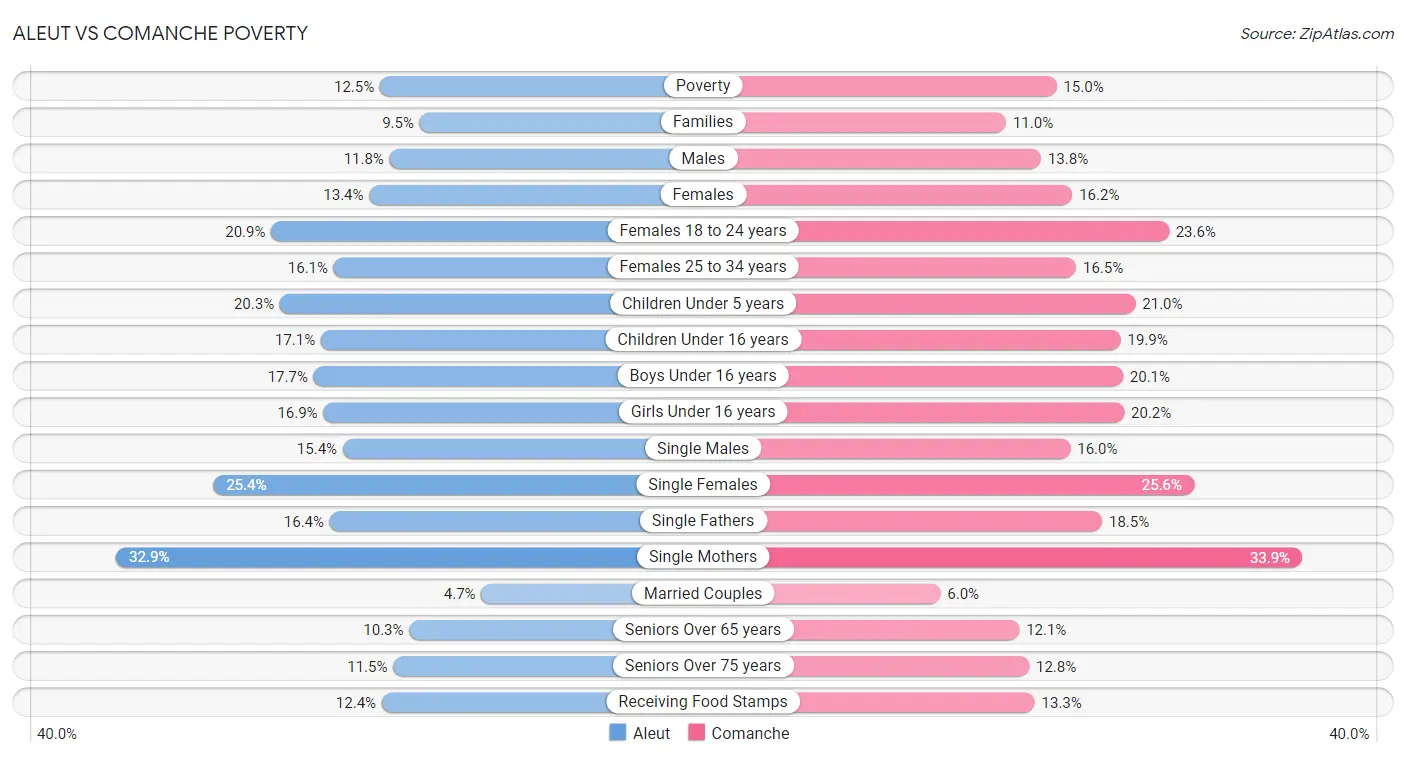
| Poverty Metric | Aleut | Comanche |
| Poverty | Fair 12.5% | Tragic 15.0% |
| Families | Poor 9.5% | Tragic 11.0% |
| Males | Poor 11.8% | Tragic 13.8% |
| Females | Average 13.4% | Tragic 16.2% |
| Females 18 to 24 years | Tragic 20.9% | Tragic 23.6% |
| Females 25 to 34 years | Tragic 16.1% | Tragic 16.5% |
| Children Under 5 years | Tragic 20.3% | Tragic 21.0% |
| Children Under 16 years | Poor 17.1% | Tragic 19.9% |
| Boys Under 16 years | Tragic 17.7% | Tragic 20.1% |
| Girls Under 16 years | Fair 16.9% | Tragic 20.2% |
| Single Males | Tragic 15.4% | Tragic 16.0% |
| Single Females | Tragic 25.4% | Tragic 25.6% |
| Single Fathers | Fair 16.4% | Tragic 18.5% |
| Single Mothers | Tragic 32.9% | Tragic 33.9% |
| Married Couples | Exceptional 4.7% | Tragic 6.0% |
| Seniors Over 65 years | Exceptional 10.3% | Tragic 12.1% |
| Seniors Over 75 years | Exceptional 11.5% | Tragic 12.8% |
| Receiving Food Stamps | Poor 12.4% | Tragic 13.3% |
Aleut vs Comanche Unemployment
When considering unemployment, the most significant differences between Aleut and Comanche communities in the United States are seen in unemployment among seniors over 75 years (10.3% compared to 6.7%, a difference of 53.9%), unemployment among ages 20 to 24 years (13.8% compared to 10.2%, a difference of 36.3%), and unemployment among ages 60 to 64 years (6.8% compared to 5.0%, a difference of 34.4%). Conversely, both communities are more comparable in terms of female unemployment (5.5% compared to 5.4%, a difference of 1.9%), unemployment among ages 16 to 19 years (21.2% compared to 20.2%, a difference of 4.5%), and unemployment among women with children ages 6 to 17 years (9.6% compared to 9.0%, a difference of 6.6%).
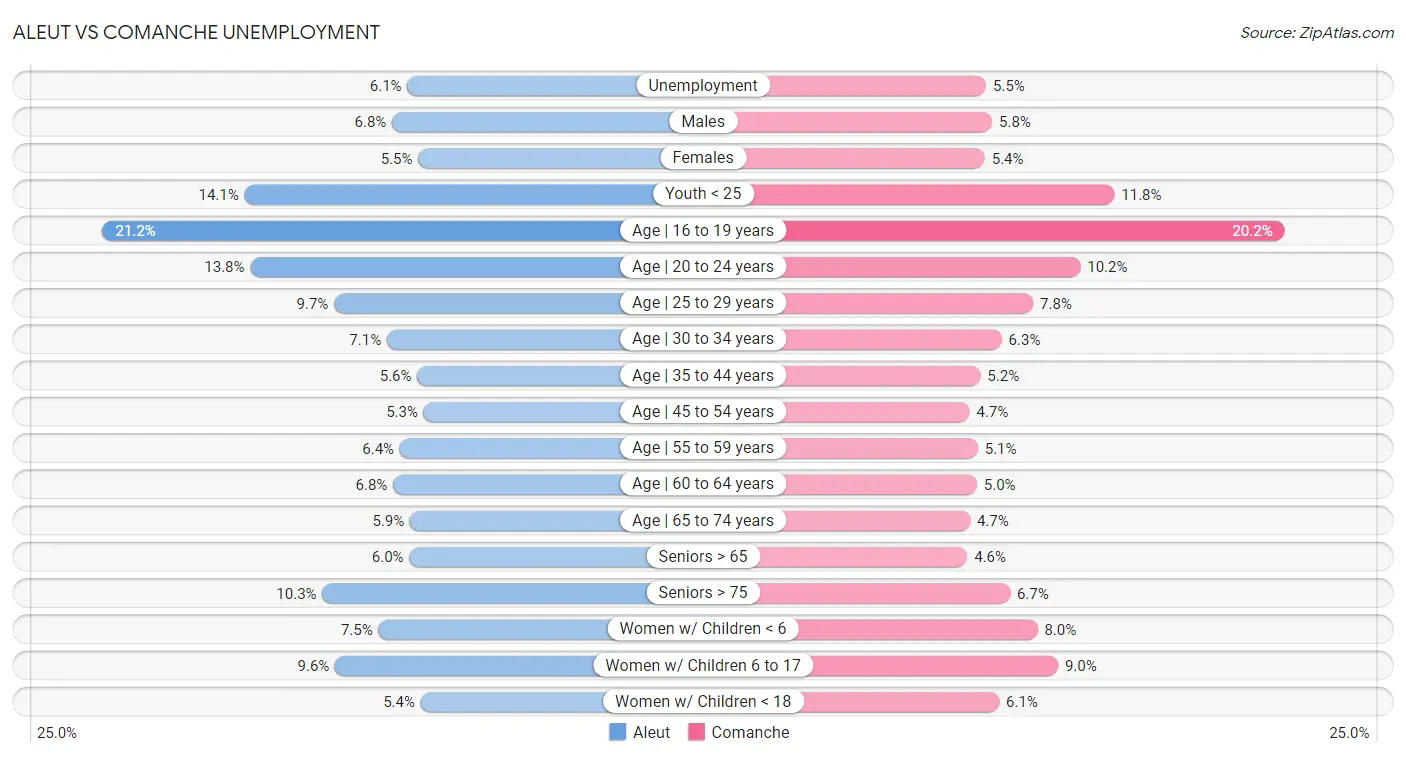
| Unemployment Metric | Aleut | Comanche |
| Unemployment | Tragic 6.1% | Tragic 5.5% |
| Males | Tragic 6.8% | Tragic 5.8% |
| Females | Tragic 5.5% | Poor 5.4% |
| Youth < 25 | Tragic 14.1% | Poor 11.8% |
| Age | 16 to 19 years | Tragic 21.2% | Tragic 20.2% |
| Age | 20 to 24 years | Tragic 13.8% | Excellent 10.2% |
| Age | 25 to 29 years | Tragic 9.7% | Tragic 7.8% |
| Age | 30 to 34 years | Tragic 7.1% | Tragic 6.3% |
| Age | 35 to 44 years | Tragic 5.6% | Tragic 5.2% |
| Age | 45 to 54 years | Tragic 5.3% | Tragic 4.7% |
| Age | 55 to 59 years | Tragic 6.4% | Tragic 5.1% |
| Age | 60 to 64 years | Tragic 6.8% | Tragic 5.0% |
| Age | 65 to 74 years | Tragic 5.9% | Exceptional 4.7% |
| Seniors > 65 | Tragic 6.0% | Exceptional 4.6% |
| Seniors > 75 | Tragic 10.3% | Exceptional 6.7% |
| Women w/ Children < 6 | Good 7.5% | Tragic 8.0% |
| Women w/ Children 6 to 17 | Tragic 9.6% | Fair 9.0% |
| Women w/ Children < 18 | Average 5.4% | Tragic 6.1% |
Aleut vs Comanche Labor Participation
When considering labor participation, the most significant differences between Aleut and Comanche communities in the United States are seen in in labor force | age 16-19 (40.4% compared to 37.7%, a difference of 7.3%), in labor force | age 20-24 (79.0% compared to 75.4%, a difference of 4.8%), and in labor force | age > 16 (66.0% compared to 63.6%, a difference of 3.7%). Conversely, both communities are more comparable in terms of in labor force | age 30-34 (82.6% compared to 82.6%, a difference of 0.0%), in labor force | age 20-64 (78.2% compared to 77.0%, a difference of 1.5%), and in labor force | age 25-29 (83.4% compared to 81.9%, a difference of 1.9%).

| Labor Participation Metric | Aleut | Comanche |
| In Labor Force | Age > 16 | Exceptional 66.0% | Tragic 63.6% |
| In Labor Force | Age 20-64 | Tragic 78.2% | Tragic 77.0% |
| In Labor Force | Age 16-19 | Exceptional 40.4% | Exceptional 37.7% |
| In Labor Force | Age 20-24 | Exceptional 79.0% | Good 75.4% |
| In Labor Force | Age 25-29 | Tragic 83.4% | Tragic 81.9% |
| In Labor Force | Age 30-34 | Tragic 82.6% | Tragic 82.6% |
| In Labor Force | Age 35-44 | Average 84.4% | Tragic 81.5% |
| In Labor Force | Age 45-54 | Tragic 81.0% | Tragic 79.2% |
Aleut vs Comanche Family Structure
When considering family structure, the most significant differences between Aleut and Comanche communities in the United States are seen in single father households (3.0% compared to 2.5%, a difference of 20.2%), divorced or separated (12.5% compared to 13.5%, a difference of 8.1%), and births to unmarried women (39.3% compared to 36.7%, a difference of 7.1%). Conversely, both communities are more comparable in terms of family households (63.4% compared to 63.5%, a difference of 0.030%), average family size (3.23 compared to 3.25, a difference of 0.64%), and family households with children (27.4% compared to 27.6%, a difference of 0.67%).

| Family Structure Metric | Aleut | Comanche |
| Family Households | Tragic 63.4% | Tragic 63.5% |
| Family Households with Children | Average 27.4% | Good 27.6% |
| Married-couple Households | Poor 45.6% | Tragic 44.5% |
| Average Family Size | Average 3.23 | Excellent 3.25 |
| Single Father Households | Tragic 3.0% | Tragic 2.5% |
| Single Mother Households | Tragic 6.8% | Tragic 7.0% |
| Currently Married | Average 46.7% | Tragic 45.0% |
| Divorced or Separated | Tragic 12.5% | Tragic 13.5% |
| Births to Unmarried Women | Tragic 39.3% | Tragic 36.7% |
Aleut vs Comanche Vehicle Availability
When considering vehicle availability, the most significant differences between Aleut and Comanche communities in the United States are seen in no vehicles in household (13.0% compared to 10.2%, a difference of 27.1%), 2 or more vehicles in household (54.1% compared to 56.5%, a difference of 4.4%), and 3 or more vehicles in household (20.2% compared to 21.0%, a difference of 3.9%). Conversely, both communities are more comparable in terms of 4 or more vehicles in household (6.9% compared to 6.8%, a difference of 1.3%), 1 or more vehicles in household (87.5% compared to 89.9%, a difference of 2.7%), and 3 or more vehicles in household (20.2% compared to 21.0%, a difference of 3.9%).

| Vehicle Availability Metric | Aleut | Comanche |
| No Vehicles Available | Tragic 13.0% | Good 10.2% |
| 1+ Vehicles Available | Tragic 87.5% | Good 89.9% |
| 2+ Vehicles Available | Tragic 54.1% | Excellent 56.5% |
| 3+ Vehicles Available | Excellent 20.2% | Exceptional 21.0% |
| 4+ Vehicles Available | Exceptional 6.9% | Exceptional 6.8% |
Aleut vs Comanche Education Level
When considering education level, the most significant differences between Aleut and Comanche communities in the United States are seen in no schooling completed (1.6% compared to 2.1%, a difference of 31.1%), doctorate degree (1.5% compared to 1.6%, a difference of 6.7%), and high school diploma (90.4% compared to 87.9%, a difference of 2.9%). Conversely, both communities are more comparable in terms of nursery school (98.7% compared to 98.0%, a difference of 0.64%), kindergarten (98.6% compared to 98.0%, a difference of 0.65%), and 1st grade (98.6% compared to 98.0%, a difference of 0.66%).
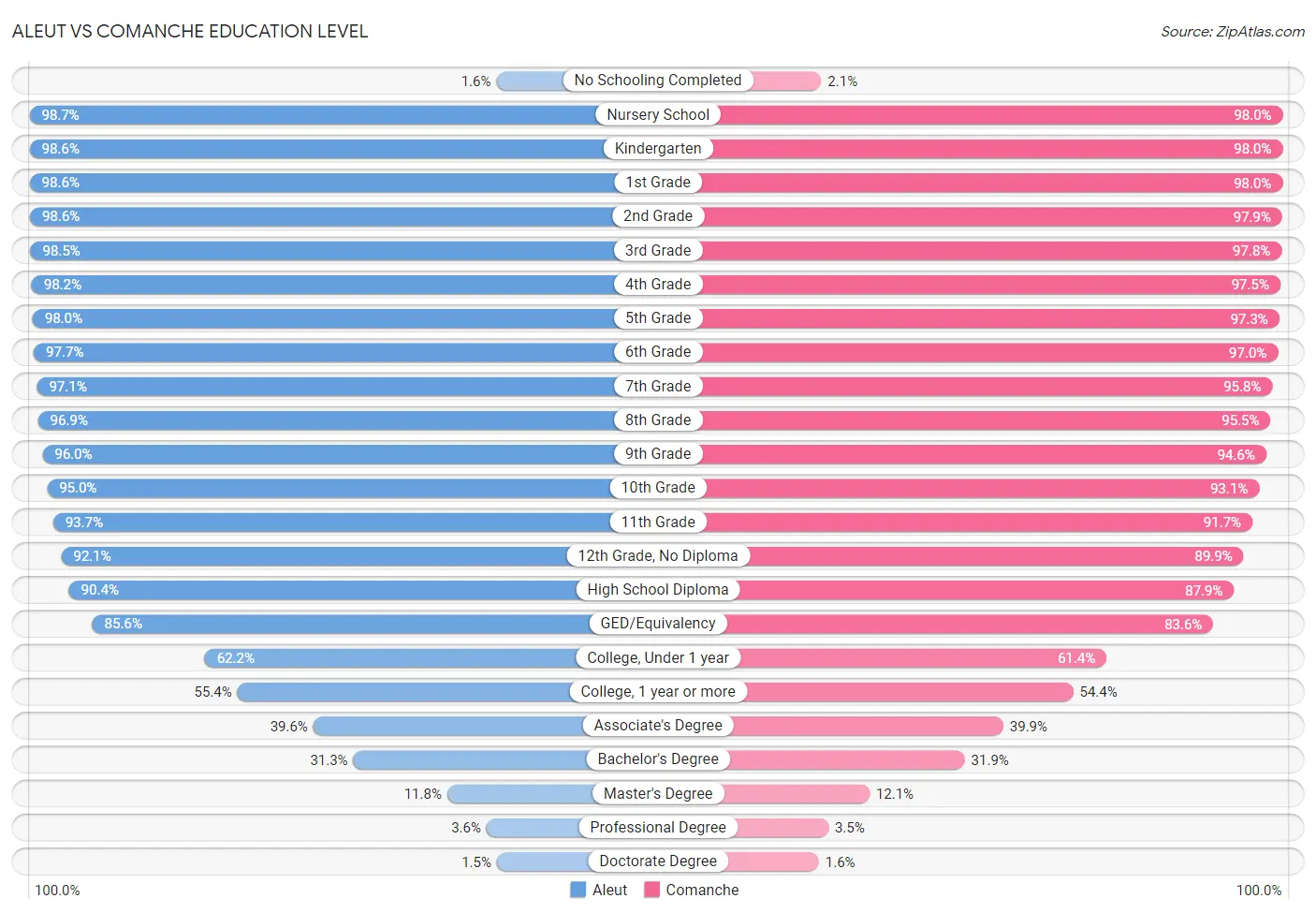
| Education Level Metric | Aleut | Comanche |
| No Schooling Completed | Exceptional 1.6% | Good 2.1% |
| Nursery School | Exceptional 98.7% | Good 98.0% |
| Kindergarten | Exceptional 98.6% | Good 98.0% |
| 1st Grade | Exceptional 98.6% | Good 98.0% |
| 2nd Grade | Exceptional 98.6% | Good 97.9% |
| 3rd Grade | Exceptional 98.5% | Average 97.8% |
| 4th Grade | Exceptional 98.2% | Average 97.5% |
| 5th Grade | Exceptional 98.0% | Average 97.3% |
| 6th Grade | Exceptional 97.7% | Fair 97.0% |
| 7th Grade | Exceptional 97.1% | Fair 95.8% |
| 8th Grade | Exceptional 96.9% | Poor 95.5% |
| 9th Grade | Exceptional 96.0% | Poor 94.6% |
| 10th Grade | Exceptional 95.0% | Tragic 93.1% |
| 11th Grade | Exceptional 93.7% | Tragic 91.7% |
| 12th Grade, No Diploma | Exceptional 92.1% | Tragic 89.9% |
| High School Diploma | Exceptional 90.4% | Tragic 87.9% |
| GED/Equivalency | Average 85.6% | Tragic 83.6% |
| College, Under 1 year | Tragic 62.2% | Tragic 61.4% |
| College, 1 year or more | Tragic 55.4% | Tragic 54.4% |
| Associate's Degree | Tragic 39.6% | Tragic 39.9% |
| Bachelor's Degree | Tragic 31.3% | Tragic 31.9% |
| Master's Degree | Tragic 11.8% | Tragic 12.1% |
| Professional Degree | Tragic 3.6% | Tragic 3.5% |
| Doctorate Degree | Tragic 1.5% | Tragic 1.6% |
Aleut vs Comanche Disability
When considering disability, the most significant differences between Aleut and Comanche communities in the United States are seen in disability age 5 to 17 (5.3% compared to 6.4%, a difference of 20.8%), ambulatory disability (6.6% compared to 7.5%, a difference of 14.6%), and female disability (12.7% compared to 14.2%, a difference of 11.6%). Conversely, both communities are more comparable in terms of disability age 65 to 74 (28.4% compared to 28.3%, a difference of 0.33%), disability age over 75 (50.6% compared to 51.7%, a difference of 2.2%), and self-care disability (2.8% compared to 2.9%, a difference of 2.5%).
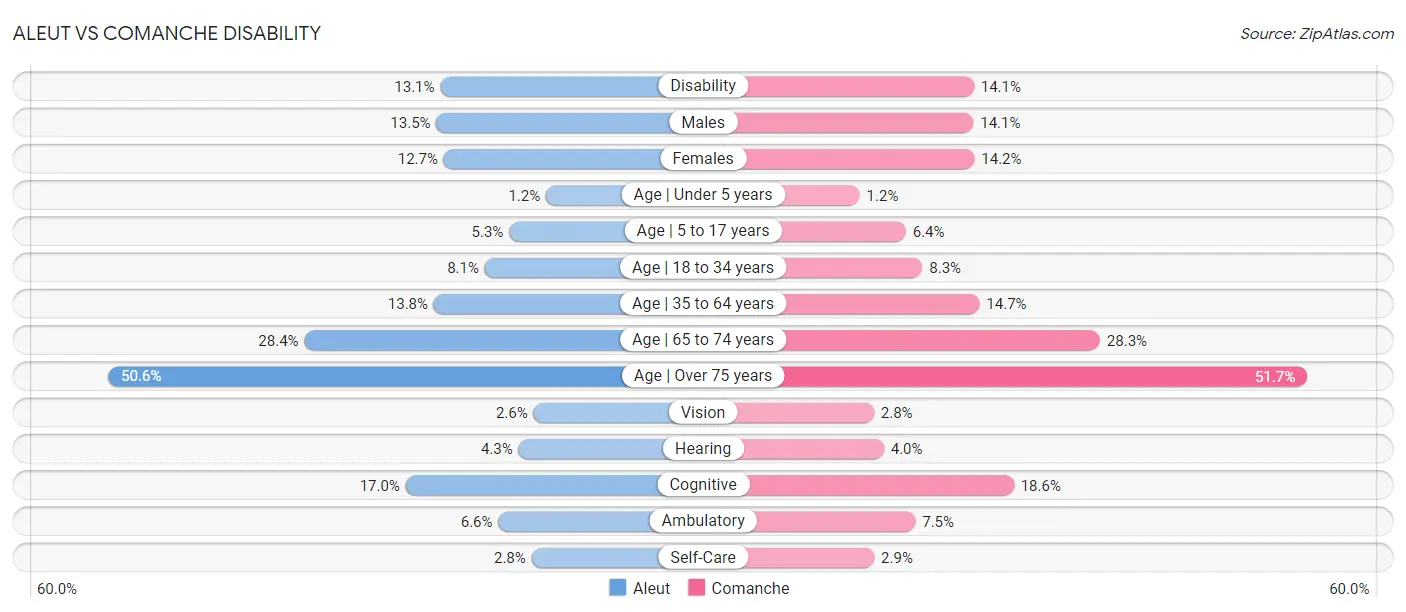
| Disability Metric | Aleut | Comanche |
| Disability | Tragic 13.1% | Tragic 14.1% |
| Males | Tragic 13.5% | Tragic 14.1% |
| Females | Tragic 12.7% | Tragic 14.2% |
| Age | Under 5 years | Exceptional 1.2% | Average 1.2% |
| Age | 5 to 17 years | Exceptional 5.3% | Tragic 6.4% |
| Age | 18 to 34 years | Tragic 8.1% | Tragic 8.3% |
| Age | 35 to 64 years | Tragic 13.8% | Tragic 14.7% |
| Age | 65 to 74 years | Tragic 28.4% | Tragic 28.3% |
| Age | Over 75 years | Tragic 50.6% | Tragic 51.7% |
| Vision | Tragic 2.6% | Tragic 2.8% |
| Hearing | Tragic 4.3% | Tragic 4.0% |
| Cognitive | Excellent 17.0% | Tragic 18.6% |
| Ambulatory | Tragic 6.6% | Tragic 7.5% |
| Self-Care | Tragic 2.8% | Tragic 2.9% |